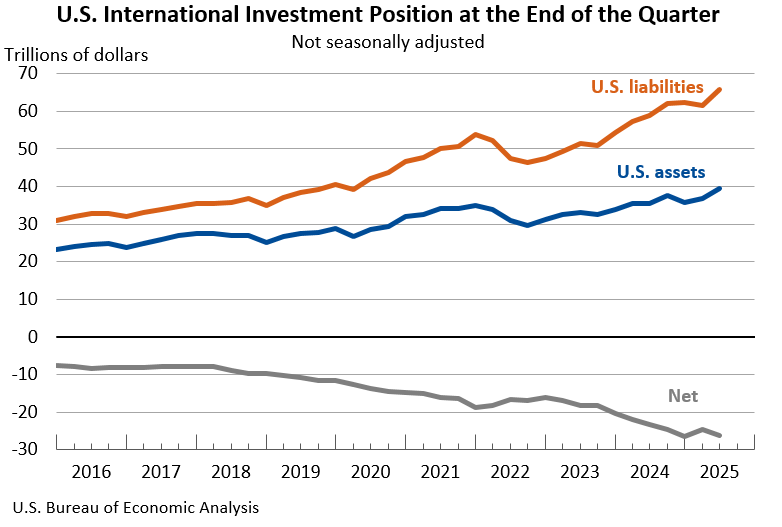Bureau of Economic Analysis
U.S. International Investment Position, 2nd Quarter 2025
The U.S. net international investment position, the difference between U.S. residents’ foreign financial assets and liabilities, was -$26.14 trillion at the end of the second quarter of 2025, according to statistics released today by the U.S. Bureau of Economic Analysis. Assets totaled $39.56 trillion, and liabilities were $65.71 trillion. At the end of the first quarter, the net investment position was -$24.65 trillion (revised).
Principal Federal Economic Indicators
Noteworthy
The Latest
U.S. International Investment Position Fourth Quarter 2019
The U.S. net international investment position, the difference between U.S. residents’ foreign financial assets and liabilities, was –$10.99 trillion at the end of the fourth quarter of 2019, according to statistics released by the U.S. Bureau of Economic Analysis (BEA). Assets totaled $29.32 trillion and liabilities were $40.31 trillion. At the end of the third quarter, the net investment position was –$10.98 trillion.
U.S. International Investment Position, Fourth Quarter and Year 2019
The U.S. net international investment position, the difference between U.S. residents’ foreign financial assets and liabilities, was –$10.99 trillion at the end of the fourth quarter of 2019, according to statistics released by the U.S. Bureau of Economic Analysis (BEA). Assets totaled $29.32 trillion and liabilities were $40.31 trillion. At the end of the third quarter, the net investment position was –$10.98 trillion.
Deputy Director Bohman Takes on Duties as Acting Director
The Bureau of Economic Analysis (BEA) announced today that Deputy Director Mary Bohman is the acting Director of the Bureau, overseeing the production of official economic statistics that provide a comprehensive, up-to-date picture of the U.S. economy.
Personal Income and Outlays, February 2020
Personal income increased 0.6 percent in February, the same increase as in January. Wages and salaries, the largest component of personal income, increased 0.5 percent in February, also the same increase as in January.
Personal Income and Outlays: February 2020
Personal income increased 0.6 percent in February, the same increase as in January. Wages and salaries, the largest component of personal income, increased 0.5 percent in February, also the same increase as in January.
GDP Increases in Fourth Quarter
Real gross domestic product increased 2.1 percent in the fourth quarter of 2019, according to the “third” estimate released by the Bureau of Economic Analysis. The growth rate is the same as in the “second” estimate released in February. In the third quarter, real GDP also increased 2.1 percent.
Gross Domestic Product, Fourth Quarter and Year 2019 (Third Estimate); Corporate Profits, Fourth Quarter and Year 2019
Real gross domestic product (GDP) increased 2.1 percent in the fourth quarter of 2019, according to the “third” estimate released by the Bureau of Economic Analysis. The growth rate is the same as in the “second” estimate released in February. In the third quarter, real GDP also increased 2.1 percent.
State Personal Income, 2019
State personal income increased 4.4 percent in 2019, after increasing 5.6 percent in 2018. In 2019, increases in earnings, property income (dividends, interest, and rent), and transfer receipts contributed to personal income growth in all states and the District of Columbia. The percent change in personal income across all states ranged from 6.1 percent in Colorado to 2.8 percent in West Virginia.
State Annual Personal Income, 2019 (Preliminary) and State Quarterly Personal Income, 4th Quarter 2019
State personal income increased 4.4 percent in 2019, after increasing 5.6 percent in 2018. In 2019, increases in earnings, property income (dividends, interest, and rent), and transfer receipts contributed to personal income growth in all states and the District of Columbia. The percent change in personal income across all states ranged from 6.1 percent in Colorado to 2.8 percent in West Virginia.
U.S. Current Account Deficit Widened in 2019
The U.S. current account deficit, which reflects the combined balances on trade in goods and services and income flows between U.S. residents and residents of other countries, widened by $7.4 billion, or 1.5 percent, to $498.4 billion in 2019. The widening mainly reflected an expanded deficit on secondary income and a reduced surplus on services that were partly offset by a reduced deficit on goods. The 2019 deficit was 2.3 percent of current…




